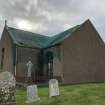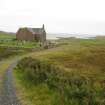Buildings at Risk Register Paused
Following the review of the Buildings at Risk Register the decision has been taken to pause the BARR in order to consider long-term options for its future.
The existing BARR website will remain accessible as a resource, however it will not be updated and we're not accepting nominations for additions to the Register.
Downtime
Please be advised that this website will undergo scheduled maintenance on the following dates:
Sunday 23rd November 18:00 to Monday 24 November 09:00
Quarff Parish Kirk, Quarff
Ordnance Survey licence number AC0000807262. All rights reserved. © Copyright and database right 2025. Public Sector Viewing Terms
Useful Links
- NRHE:
- EASTER QUARFF, QUARFF PARISH CHURCH; WAR MEMORIAL
- Historic Scotland:
- HS Reference No 12671
General Details and Location
Category
AT RISK
Name of Building
Quarff Parish Kirk
Other Name(s)
Easter Quarff
Address
Quarff
Locality
Postcode
Planning Authority
Divisional Area
Reference No
1788
Listing Category
B
OS Grid Ref
HU 42847 35447
Location Type
Rural
HS Reference No
12671
Description
4-bay T-plan symmetrical Parliamentary style church on site sloping to E. Harled walls with stugged and droved sandstone ashlar margins. Eaves course. 4-centred arched windows with modern timber tracery and glazing, and projecting, sloping cills.
Quarff was disjoined from Bressay and annexed to Lerwick Parish in 1891. This closely resembles one of the 42 standard T-plan Telford churches provided by an Act of Parliament of 1823 to meet deficiencies in the Highlands and Islands, but is in fact by Davidson and Macfarlane to Telford's design and as of additional interest as such. (Historic Scotland)
Quarff was disjoined from Bressay and annexed to Lerwick Parish in 1891. This closely resembles one of the 42 standard T-plan Telford churches provided by an Act of Parliament of 1823 to meet deficiencies in the Highlands and Islands, but is in fact by Davidson and Macfarlane to Telford's design and as of additional interest as such. (Historic Scotland)
Building Dates
1828-1829
Architects
John Davidson and Thomas MacFarlane
Category of Risk and Development History
Condition
Poor
Category of Risk
Moderate
Exemptions to State of Risk
The graveyard is in use and well-cared for.
Field Visits
January 1994, August 2000, 14/09/2008, Mar 2010, 23/6/2014, 03/10/2022
Development History
26 November 1993: The Shetland Times reports that the church is to be sold, after becoming surplus to Church of Scotland requirements. It is reported to have been disused for some time. The particulars of sale state that Shetland Council would be sympathetic to a change of use, with residential use preferred. January 1994: External inspection reveals the church to be redundant and in need of repairs. SCT understands there is the possibility that the Church will donate the property to the local community who are concerned to see it protected. July 1994: SCT receives confirmation that repairs have recently been carried out to the roof. 8 July 1994: The Shetland Times reports on the church's inclusion in the Buildings at Risk Bulletin. It is reported that the church is now sold. August 1994: SCT understands that the new owner plans to convert the church into a private dwelling. 23 December 1994: The Shetland Times reports that an interim interdict has been served on the new owners, preventing them from commencing on alterations to either the external or internal fabric without Planning Permission or Listed Building Consent, even though no works have commenced. Shetland Council, in response to the church, have developed a policy of not allowing the conversion of churches sited in graveyards that remain in use. It is reported that the church was offered to the local community after opposition to its sale was voiced, but the offer was turned down. January 1995: SCT receives information from the owner that the church bell has been removed without his permission. June 1995: SCT understands the owner is no longer in residence. January 1997: SCT understands that the church has passed to Quarff Church Trust. August 2000: External inspection reveals no work to have occurred as yet.
September 2008: External inspection finds the building remain unused and unsecured. The walls remain in good condition but some roof slates are missing which has exposed the sarking. Rainwater goods are broken or missing in places.
March 2010: External inspection finds outwardly, the church appears to remain in good condition. However, it was possible to observe from outside that plaster is coming down from the ceiling in many places.
23 June 2014: External inspection finds the building remains in much the same condition as seen previously. The interior, observed through a window, remains intact, though there is much evidence of dampness and plaster failure.
3 October 2022: External inspection finds the condition has deteriorated. Netting has been placed over the roof and a hole has developed at the north corner. Other areas of the roof have slipped and missing slates. Sections of the gutter are missing on the southeast elevation and are blocked by vegetation growth on other elevations. The walls appear to be stable with the harling still intact. The windows and doors remain intact and secured, but are weathered. Interior water ingress is visible through windows and continues to cause failure of plaster and further damage.
Guides to Development
Conservation Area
Planning Authority Contact
PAC Telephone Number
01595 744762
Availability
Current Availability
Unknown
Appointed Agents
Price
Occupancy
Vacant
Occupancy Type
N/A
Present/Former Uses
Building Uses Information: <br />
Present Use 1: N/A Former Use 1: Church/Convent/Monastery<br />
Present Use 2: N/A Former Use 2: N/A
Name of Owners
Quarff Church Trust
Type of Ownership
Charity/Trust
Information Services
Additional Contacts/Information Source
Bibliography
Finnie (1990), p44; Gifford (1992), p503; Ritchie (1985).
Online Resources
Classification
Churches and Chapels
Original Entry Date
19-JAN-94
Date of Last Edit
04/04/2023
























